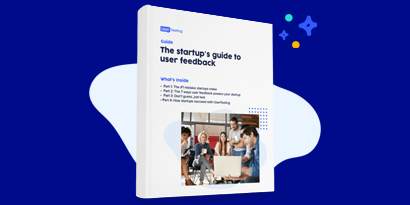FOR STARTUPS
Growing a successful startup with user feedback
Actionable insight for every stage of funding

Starting a business—even with a truly great product idea—comes with many risks. Forbes reports that 90% of startups fail, and many of those fail within their first year.
While many unexpected and external factors contribute to a startup’s success or failure, founders have control over how much they listen to user feedback at each stage of their business. Validating a product idea early and testing it with your market is one of the most effective ways to increase your chances of success.
Many founders only start testing their product after it’s already built and ready to launch, which in many cases, is already too late. If the team has spent months designing and developing a product, only to find out right before launching that it has major usability issues, feature bloat, or poor product-market fit, it’s game over for the company.
Keep reading to learn which types of research founders and product teams should be conducting at each startup funding stage, including what to test and what you can expect to learn.
After your product is launched and you’ve found product-market fit, you can shift your research goals to focus on building a winning product roadmap. Test with your target market to generate, evaluate, and prioritize new feature ideas. You may conduct as many prototype tests for new features as you did with a new product in earlier stages.
Your product may go through some growing pains at this stage as your early customers start to hit issues and limits with what they can do with the product. Continue testing with your existing customer base to hear what they wish were different now that they’ve been using the product for a while. Where do they revert to previous solutions because your product isn’t robust enough yet? What pain points do power users encounter?
At this stage, you’re likely getting a lot of feedback from many channels: sales calls, customer support inquiries, and online reviews. User testing allows you to dig deep into those suggestions and pain points, uncovering potential solutions and areas for growth.
As you spread to a wider customer base, test your marketing campaign ideas to take the guesswork and risk out of bigger, more expensive campaigns.
Tips for testing in Series A
- Start sharing user insights within the company as your team grows.
- Consider linking to relevant video clips and highlight reels in your product roadmap for quick access.
- Combine qualitative insights with quantitative methods like A/B tests and surveys to better understand what users are doing and thinking.
In this stage, you’re experiencing rapid growth in your customer base and within your company. While you may not be conducting as many prototype tests or doing the exploratory research you did earlier, it’s critical to remain close to the customer and build a culture of customer-centricity in your company.
By now, testing your product features is a built-in part of your process. Continue testing to help with feature prioritization and product refinement. Now that your product is more well-established, it’s a good time to start running benchmark studies so you can track the progress of your product’s user experience over time.
You may notice that there are already changing expectations and demands from your users, influenced by other innovative products and user experiences they’ve had. Run competitor studies to explore how your target market feels about your competitors’ offerings.
As your marketing efforts expand, test your website consistently to optimize conversion rates and validate your messaging.
Tips for testing in Series B
- Ensure your internal teams can easily share and organize their studies and findings.
- Lean on your product and web analytics to pinpoint any areas of concern that need further research.
- Share out customer insights with the broader team consistently.
Once you’ve reached Series C, you’re likely focusing on scale. This may include expanding into new markets—either internationally, into different buyer personas, or upmarket. Market research will help you gauge those markets’ current thoughts about your product so you can identify areas of prioritization, from new features to different messaging.
At this stage, you may also be expanding your product significantly. Surprisingly, you can benefit from some of the same exploratory research that you did in your pre-launch days, but with a goal of identifying possible new products or markets.
Your team is likely much larger by now, and you’re probably running far more tests than you used to. It can be helpful to lean on advanced technologies like click maps and behavior analysis to preserve valuable team time and get the fastest path to insight from your research.
Tips for testing in Series C
- Remember your early days and keep an open mind as you test with new markets and explore significant product expansion opportunities.
- Watch out for internal blockers and complexity in your research process as your team grows.
- Lead by example to build a customer-centric company.
FREE GUIDE
The startup's guide to user feedback
Learn why fast, iterative feedback is critical to any startup's success—and how to incorporate it into your team's process now.

User insight is the key to a startup’s success
While not every startup will succeed, listening to user feedback can help you stack the deck in your own favor. As your startup grows into a larger company, don’t forget to reflect on how user feedback has shaped the product journey and the success of your company.
Continue testing your product and gauging market sentiment as you prepare for your company’s next stages, whether it’s IPO, an acquisition, or simply growth and profitability.

Build the right product, for the right customers, at the right time
Watch people engage with your products, apps, or services and get a vivid, first-person understanding of any experience—fast.


